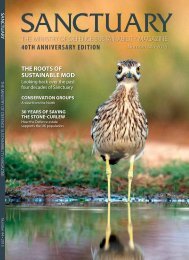SUSTAINABILITY
UC30G
UC30G
Create successful ePaper yourself
Turn your PDF publications into a flip-book with our unique Google optimized e-Paper software.
FEATURES<br />
ARC and the MOD<br />
a long term partnership<br />
Woolmer Pond Longmoor © Crown<br />
One of the key mechanisms that allowed this work to take<br />
place on a sustainable level was the formation, in 1974, of<br />
the very first MOD Conservation Group at Longmoor Camp.<br />
this time we have continued to<br />
work together across a range of very<br />
important sites, which collectively form<br />
a secure and robust core of sites across<br />
the south of the country.<br />
For a small organisation such as<br />
Amphibian and Reptile Conservation<br />
(ARC) that is dedicated to conserving<br />
our native reptiles and amphibians,<br />
managing and protecting important<br />
areas of wildlife habitat has always<br />
been one of our primary activities.<br />
Forming strong alliances with large<br />
land-owning bodies has always been<br />
a key aspect in this task and it is our<br />
long-standing working relationship<br />
with the Defence Infrastructure<br />
Organisation that we are perhaps<br />
most proud of.<br />
This relationship dates back to 1969<br />
when the British Herpetological<br />
Society (BHS) Conservation Committee<br />
carried out much needed ‘scrub<br />
bashing’ tasks on various heathland<br />
sites in Surrey, Hampshire and Dorset ,<br />
including some owned by the military,<br />
in an attempt to reverse the declines<br />
that were affecting species such as the<br />
sand lizard Lacerta agilis and natterjack<br />
toad Epidalea calamita.<br />
The BHS CC gave rise to the UK’s<br />
first professional herpetological<br />
conservation organisation, the<br />
Herpetological Conservation Trust<br />
(HCT) who continued and built upon<br />
the good work of the BHS. The HCT<br />
became ARC in 2009, retaining largely<br />
the same staff and with a similar,<br />
albeit more wide-ranging ambition<br />
to protect and enhance our native<br />
reptiles and amphibians. Throughout<br />
One of the key mechanisms that<br />
allowed this work to take place on a<br />
sustainable level was the formation,<br />
in 1974, of the very first MOD<br />
Conservation Group at Longmoor<br />
Camp. This innovation was down<br />
to the vision of the late MOD<br />
Conservation Offcer Lt Col Norman<br />
Clayden MBE and has given rise to the<br />
formation of over 100 similar groups<br />
that thrive to this day and form a vital<br />
forum for conservation practitioners<br />
and the military to work together<br />
and achieve their combined goals.<br />
Col Clayden was also instrumental in<br />
the creation of the magazine you are<br />
reading now; Sanctuary, which began<br />
in 1975. Some of the earliest and most<br />
important work of the Longmoor<br />
68<br />
Sanctuary 44 • 2015



